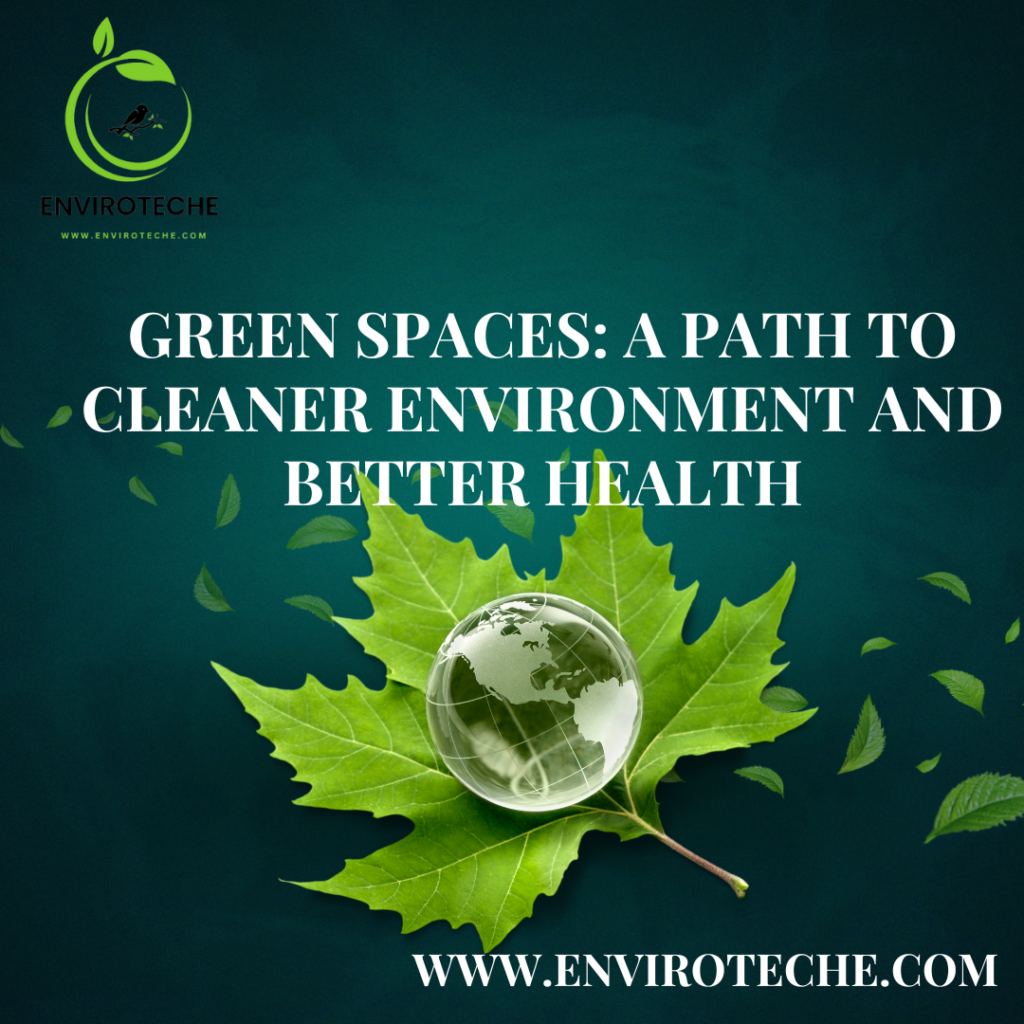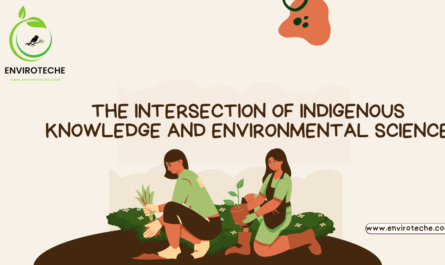
Irfan Haidri1, Aneeza Ishfaq1
1Department of Environmental Sciences, Government College University Faisalabad
Abstract
Parks, gardens, forests, and urban green areas all have the remarkable potential to address two of the most pressing issues facing the world today: environmental pollution and human health. Pollution levels rise as industrialization and urbanization pick up speed, endangering the health of both the environment and people. However, incorporating green areas into urban landscapes can have a number of advantages, including acting as natural pollution filters and enhancing human health and well-being. This blog highlights the value of green spaces in developing sustainable and healthy communities while examining their potential to lower environmental pollution and improve human health.
In this blog, we discussed green places importance and their impact on human physical and mental health maintenance.
Green spaces Introduction
Green spaces are essential for lowering air pollution. Plants absorb carbon dioxide from the air and release oxygen through photosynthesis, which enhances air quality (SETYOWATI et al., n.d.). Additionally, green spaces serve as natural filters that capture particulates and harmful pollutants like sulfur dioxide and nitrogen dioxide.
Urban green spaces can act as buffers, reducing the effects of air pollution on nearby communities when placed strategically near industrial areas or congested roads (Koricho et al., 2022). By preventing pollutants from entering water bodies, green spaces help regulate the quality of the water. Parks and wetlands’ vegetation and soil serve as natural filters, capturing and absorbing runoff contaminants like fertilizers and heavy metals.
Additionally, green infrastructure, like green roofs and rain gardens, can lessen storm water runoff, lowering the risk of flooding and water pollution (Koricho et al., 2022). Urban green areas offer a refuge from noise pollution, offering peace and supporting mental health.
By absorbing and reflecting sound, trees and other vegetation serve as sound barriers that lessen the impact of urban noise on nearby residential areas. In addition to providing a more tranquil setting, parks and gardens enable people to escape the city’s bustle (Song et al., 2020).
Public physical and mental Health
Green spaces promote a healthier lifestyle and lower the risk of chronic diseases like obesity, cardiovascular disease, and diabetes by encouraging physical activity (Slater et al., 2020). In order to improve overall fitness levels, parks and recreational areas offer opportunities for exercise, jogging, cycling, and other outdoor activities.
Accessible green spaces also promote active transportation, like biking and walking, which lessens reliance on automobiles and the resulting air pollution. Green spaces offer opportunities for exercise and physical activity, both of which have significant positive effects on mental health. Exercise in green spaces, such as walking, jogging, or yoga, not only improves physical fitness but also releases endorphins, or “feel-good” hormones, which improve mood and lessen depressive symptoms (Koricho et al., 2022).
Physical exercise and exposure to nature work together synergistically to enhance the benefits on mental health. Additionally, green spaces encourage community involvement and social interactions, both of which are crucial for mental health. In order to foster a sense of community and social support, parks and recreational areas act as meeting places for locals.
For instance, community gardens give people the chance to interact, exchange stories, and form deep connections. These social interactions help people feel happier, less lonely, and have better mental health in general (Ali et al., 2022). Engaging in outdoor activities improves mental health by lowering stress, anxiety, and depression.
Urban pressures are relieved by green spaces, which also promote calmness and relaxation. Time spent outdoors has been linked to improved cognitive performance and attention recovery, which boosts productivity and creativity (Collins et al., 2022). Additionally, the social components of green spaces, like shared recreational areas or community gardens, encourage social interaction, fight social isolation, and foster a sense of community.
Green areas frequently act as social hubs, uniting neighborhoods and fostering interpersonal relationships. Gardens, parks, and recreation centers in communities provide places for social interaction, fostering a sense of community and preventing social isolation (Elsadek et al., 2020). Activities with others in a natural environment promote a sense of community and support, which enhances mental health.
They offer a respite from the stresses of city life, opportunities for exercise, sensory stimulation, and social interaction. To maintain mental health in a world that is becoming more urbanized and fast-paced, we must incorporate green spaces into our daily lives. Whether it’s going for a walk in the park, taking care of a garden, or just being in the presence of nature, embracing green spaces can have a positive impact on our mental health and lead to a happier and more fulfilling life (Malekinezhad et al., 2020).
Environmental Education and Awareness
By providing opportunities for environmental education and awareness, green spaces act as living classrooms. Visitors can learn about the value of biodiversity, conservation, and sustainable practices in parks and botanical gardens. Interacting with nature fosters environmental stewardship and promotes sustainable behaviors by instilling a sense of responsibility towards the environment (Faraji & Karimi, 2022).
Creating Sustainable and Healthy Communities
Urban Planning and Design: Green space integration is essential for developing sustainable and wholesome communities. Cities can boost biodiversity, reduce the effects of urban heat islands, and improve air quality by prioritizing the inclusion of parks, gardens, and greenways (Nieuwenhuijsen, 2021).
Urban areas are more aesthetically pleasing and more livable when green spaces are well-designed. Maximizing the potential for green spaces to enhance human health requires ensuring equitable access to them. All communities, including underserved areas, should have easy access to green spaces that are distributed evenly.
As a result, social equity is promoted, health disparities are decreased, and community wellbeing is improved (Jaung et al., 2020). For the sake of biodiversity and ecosystem preservation, it is essential to protect, restore, and create new green spaces. Reforestation, wetlands preservation, and the creation of wildlife habitats in urban areas can all be the focus of conservation efforts. Such programs improve community resilience and environmental sustainability while also improving community health (Xiao et al., 2018).
Conclusion
The potential for green spaces to reduce environmental pollution and enhance human health is enormous. Green spaces provide a variety of advantages, from promoting physical and mental wellbeing to acting as natural filters to lessen air, water, and noise pollution.
They promote environmental education and awareness while offering areas for leisure, exercise, and relaxation. Sustainable and healthy communities can be developed by incorporating green spaces into urban planning, prioritizing equitable access, and placing an emphasis on conservation efforts. Investing in green spaces becomes essential for a sustainable future as we battle environmental pollution and its harmful effects on human health.
The potential of green spaces must be acknowledged and given top priority by governments, urban planners, and local communities in order to ensure their preservation and growth for the sake of the environment and the welfare of people. We can build communities that are healthier, happier, and more resilient for future generations by utilizing the power of nature.
References
Ali, M. J., Rahaman, M., & Hossain, S. I. (2022). Urban green spaces for elderly human health: A planning model for healthy city living. Land Use Policy, 114, 105970.
Collins, C., Haase, D., Heiland, S., & Kabisch, N. (2022). Urban green space interaction and wellbeing–investigating the experience of international students in Berlin during the first COVID-19 lockdown. Urban Forestry & Urban Greening, 70, 127543.
Elsadek, M., Liu, B., & Xie, J. (2020). Window view and relaxation: Viewing green space from a high-rise estate improves urban dwellers’ wellbeing. Urban Forestry & Urban Greening, 55, 126846.
Faraji, L., & Karimi, M. (2022). Botanical gardens as valuable resources in plant sciences. Biodiversity and Conservation, 31(12), 2905–2926.
Jaung, W., Carrasco, L. R., Shaikh, S. F. E. A., Tan, P. Y., & Richards, D. R. (2020). Temperature and air pollution reductions by urban green spaces are highly valued in a tropical city-state. Urban Forestry & Urban Greening, 55, 126827.
Koricho, H. H., Seboka, A. D., Fufa, F., Gebreyesus, T., & Song, S. (2022). Study on the ecosystem services of urban forests: implications for climate change mitigation in the case of Adama City of Oromiya Regional Sate, Ethiopia. Urban Ecosystems, 1–10.
Malekinezhad, F., Courtney, P., bin Lamit, H., & Vigani, M. (2020). Investigating the mental health impacts of university campus green space through perceived sensory dimensions and the mediation effects of perceived restorativeness on restoration experience. Frontiers in Public Health, 8, 578241.
Nieuwenhuijsen, M. J. (2021). New urban models for more sustainable, liveable and healthier cities post covid19; reducing air pollution, noise and heat island effects and increasing green space and physical activity. Environment International, 157, 106850.
SETYOWATI, D. L., HARDATI, P., HANDOYO, E. K. O., AMIN, M., NAYAN, N., & HASHIM, M. (n.d.). POTENTIALS OF GREEN OPEN SPACES IN AIR QUALITY CONTROL OF SEMARANG CITY, INDONESIA.
Slater, S. J., Christiana, R. W., & Gustat, J. (2020). Peer Reviewed: Recommendations for keeping parks and green space accessible for mental and physical health during COVID-19 and other pandemics. Preventing Chronic Disease, 17.
Song, P., Kim, G., Mayer, A., He, R., & Tian, G. (2020). Assessing the ecosystem services of various types of urban green spaces based on i-Tree Eco. Sustainability, 12(4), 1630.
Xiao, X. D., Dong, L., Yan, H., Yang, N., & Xiong, Y. (2018). The influence of the spatial characteristics of urban green space on the urban heat island effect in Suzhou Industrial Park. Sustainable Cities and Society, 40, 428–439.
Read Other Scientific Information:
